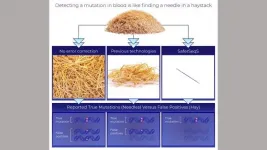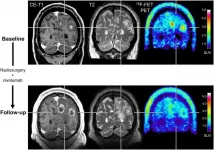(Press-News.org) Harsh prison sentences for juvenile crimes do not reduce the probability of conviction for violent crimes as an adult, and actually increase the propensity for conviction of drug-related crimes, finds a new study by economists at UC Riverside and the University of Louisiana. Harsh juvenile sentences do reduce the likelihood of conviction for property crimes as an adult. But the increase in drug-related crimes cancels out any benefit harsh sentences might offer, researchers found.
"Juvenile incarceration is a double-edged sword which deters future property crimes but makes drug convictions more likely in adulthood. Thus, it's hard to make firm policy recommendations about sentencing," said first author Ozkan Eren, a professor of economics at UC Riverside. "That said, reducing time spent in prison combined with incorporating better rehabilitation programs into nonincarceration punishment may produce welfare-improving outcomes for convicted juveniles."
Eren and Naci Mocan at the University of Louisiana obtained special permission to view juvenile conviction records from the Louisiana Department of Public Safety and Corrections, Youth Services, Office of Juvenile Justice and reviewed records from the Louisiana Department of Public Safety and Corrections, Adult Services from 1996-2012. Each case record included demographic information about the juvenile or adult, the exact statute offense committed, and details about convictions and sentencing.
To measure recidivism, the researchers focused on juvenile case files from 1996 to 2004. This corresponded to the cohorts born between 1979 and 1987 and the researchers followed them until each one reached 25, observing their criminal conviction activity as young adults. All juveniles included in the study had been randomly assigned to a judge.
The average juvenile incarceration rate was about 25%, with an average age at conviction of 15 years old. Property and drug-related juvenile offenses comprised half of all juvenile convictions. As adults, about 39% of juvenile delinquents were convicted of another crime by age 25. Adults who had been incarcerated as juveniles had a 54.7% conviction rate. Those who had received probation or punishment other than incarceration as juveniles had a much lower conviction rate-- 33.5%.
Eren and Mocan found that juvenile incarceration overall had basically no effect on adult crime. They found, however, that incarceration influenced the types of crimes for which adults were convicted. While incarceration as juveniles had no effect on adult convictions for violent crimes, it reduced the likelihood of property crimes and increased the probability of drug convictions by 28%.
"In summary, juvenile incarceration, triggered by exposure to a harsher juvenile judge, has a deterrent effect on adult property crime conviction, a positive impact on conviction from a drug offense as an adult, and no effect on adult violent crime," the authors write.
The authors suggest a reason for these outcomes is that, during the period studied, Louisiana offered well-monitored, well-structured treatment programs for the incarcerated. Incarcerated juveniles had to participate in case-specific services and programs with quarterly evaluations of their rehabilitation by professional caseworkers. These plans included vocational training, which could lead to better job prospects and reduced propensity to commit property crimes.
But life in prison took an emotional toll. Of the individuals later convicted as adults for drug-related offenses, 95% received suspended sentences or probation, indicating that the overwhelming majority of convictions were for drug use rather than selling. The authors suggest that the stress and stigma of incarceration early in life contributed to substance abuse.
They also noted that incarceration had a detrimental impact on high school completion in earlier cohorts, but it had no impact on later cohorts. This is arguably because the school reforms Louisiana implemented in the early 2000s made it more difficult to obtain a high school diploma. That led to a decline in the graduation rate of the non-incarcerated population, while not altering the already-low graduation rate of those who are incarcerated.
The study concludes that less prison time¬--non-carceral options such as probation, or shorter sentences-- and better rehabilitation programs would maintain or improve current recidivism rates and possibly make a big reduction in drug-related crimes by reducing emotional distress.
INFORMATION:
The paper, "Juvenile punishment, high school graduation, and adult crime: evidence from idiosyncratic judge harshness," is published in The Review of Economics and Statistics.
Scientists believe a stomach-specific protein plays a major role in the progression of obesity, according to new research in Scientific Reports. The study co-authored by an Indiana University School of Medicine researcher, could help with development of therapeutics that would help individuals struggling with achieving and maintaining weight loss.
Researchers focused on Gastrokine-1 (GKN1) -- a protein produced exclusively and abundantly in the stomach. Previous research has suggested GKN1 is resistant to digestion, allowing it to pass into the intestine and interact with microbes in the gut.
In the Scientific Reports study, researchers show that inhibiting GKN1 produced significant differences in weight and levels of body fat in comparison to when the protein was expressed.
"While ...
Next-generation gene sequencing (NGS) technologies --in which millions of DNA molecules are simultaneously but individually analyzed-- theoretically provides researchers and clinicians the ability to noninvasively identify mutations in the blood stream. Identifying such mutations enables earlier diagnosis of cancer and can inform treatment decisions. Johns Hopkins Kimmel Cancer Center researchers developed a new technology to overcome the inefficiencies and high error rates common among next-generation sequencing techniques that have previously limited their clinical application.
To correct for these sequencing errors, the research team from the Ludwig Center and Lustgarten Laboratory at the Johns Hopkins ...
ROCHESTER, Minn. -- A pair of Mayo Clinic studies shed light on something that is typically difficult to see with the eye: respiratory aerosols. Such aerosol particles of varying sizes are a common component of breath, and they are a typical mode of transmission for respiratory viruses like COVID-19 to spread to other people and surfaces.
Researchers who conduct exercise stress tests for heart patients at Mayo Clinic found that exercising at increasing levels of exertion increased the aerosol concentration in the surrounding room. Then also found that a high-efficiency particulate air (HEPA) device effectively filtered out the aerosols and decreased the time needed to ...
Reston, VA--For patients with brain metastases, amino acid positron emission tomography (PET) can provide valuable information about the effectiveness of state-of-the-art treatments. When treatment monitoring with contrast-enhanced magnetic resonance imaging (MRI) is unclear, adding 18F-FET PET can help to accurately diagnose recurring brain metastases and reliably assess patient response. This research was published in The Journal of Nuclear Medicine.
Newer treatment options for patients with brain metastases--such as immune checkpoint inhibitors and targeted therapies--are effective, but can cause a variety of side effects. ...
The human immune system doesn't just protect our health, it reflects it. Each encounter with a potential disease-causing agent causes the body to produce specific immune agents -- proteins known as antibodies and T-cell receptors -- tailor-made to recognize and destroy the invader. Tasked with preventing re-infection, antibodies and T-cell receptors (TCR) from your previous encounters circulate throughout the body indefinitely, like a record of your personal medical history that you carry inside of you.
Clinical pathologist Ramy Arnaout, MD, DPhil, ...
WASHINGTON, DC -- A new case report, detailed in Annals of Emergency Medicine, is the first known case of a patient with VITT (vaccine-induced thrombotic thrombocytopenia) treated with a heparin alternative following the Centers for Disease Control and Prevention (CDC) guidance.
An otherwise healthy female patient in her 40s came to the emergency department at UCHealth University of Colorado Hospital twelve days after receiving the Johnson & Johnson vaccine with a headache, dizziness, and vision changes. The patient was treated on April 13, 2021, the same day that the Centers for Disease Control and Prevention (CDC) announced a pause in the administration of the Johnson & Johnson vaccine. CDC guidance recommended ...
You know that raw overwhelm people have been reporting after months of a pandemic, compounded by economic issues and social unrest? Does fatigue and compulsive social media scrolling strike a familiar chord?
Those brittle feelings offer us a glimpse into what regular life can be like for individuals with sensory processing sensitivity (SPS), a biological trait possessed by roughly a third of the population. In a world of constant information overload and stress, it's a characteristic that can result in a variety of behaviors, from emotional outbursts to withdrawal, overwhelm and procrastination.
"Behaviorally, we observe it as being more careful and cautious when approaching new things," said Bianca Acevedo, a researcher ...
Boulder, Colo., USA: The Geological Society of America regularly publishes
articles online ahead of print. For April, GSA Bulletin topics
include multiple articles about the dynamics of China and Tibet; the Bell
River hypothesis that proposes that an ancestral, transcontinental river
occupied much of northern North America during the Cenozoic Era; new
findings in the climatic history during one of the Earth's coldest periods:
The Late Paleozoic Ice Age; and the age an nature of the Chicxulub impact
crater. You can find these articles at END ...
PHILADELPHIA - Lung cancer is the third most common cancer in the U.S. and the leading cause of cancer death, with about 80% of the total 154,000 deaths recorded each year caused by cigarette smoking. Black men are more likely to develop and die from lung cancer than persons of any other racial or ethnic group, pointing to severe racial disparities. For example, research has shown that Black patients are less likely to receive early diagnosis and life-saving treatments like surgery. Now researchers at Jefferson have found that a commonly used risk prediction model does not accurately identify high-risk Black patients who could gain life-saving benefit from early screening, and paves the way for improving screenings and guidelines. The research was published in JAMA Network ...
A new study, published in JCI Insight, looks at how Brd4, a regulator of the innate immune response, influences diet-induced obesity. The researchers believe that Brd4 could be used as a target for obesity and insulin resistance.
Approximately one-third of the adults and one in five children in the U.S. have obesity problems. Unfortunately, the condition is also associated with the development of other diseases including diabetes, cardiovascular disorders, and cancer. "One of the biggest challenges we face is trying to understand how people develop obesity. If we can understand that, we can develop solutions for treating or preventing these diseases," said Lin-Feng Chen (MME), a professor of biochemistry.
The researchers investigated the role of the ...


